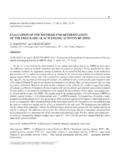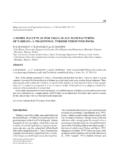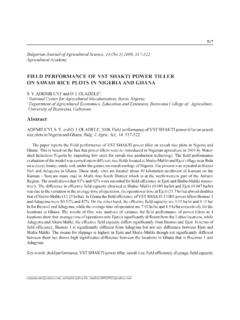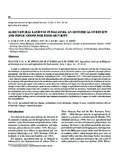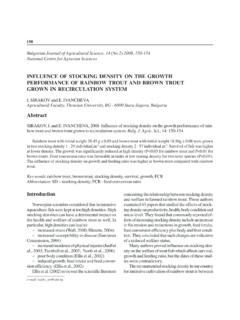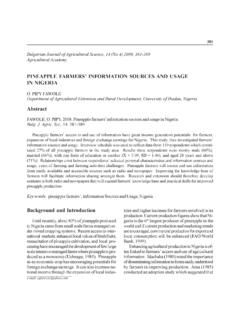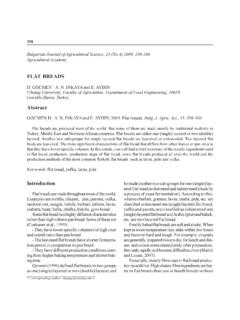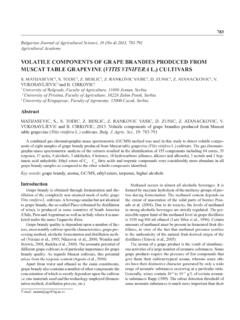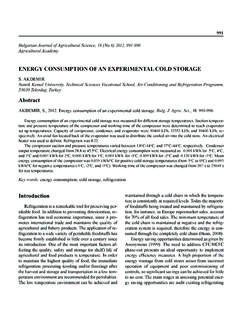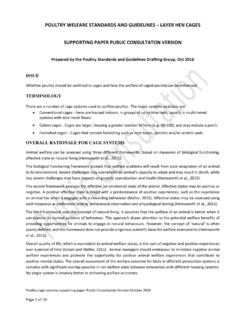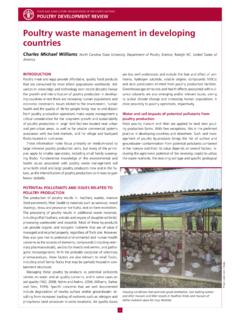Transcription of EFFECT OF POULTRY HOUSING SYSTEMS ON EGG …
1 953 EFFECT OF POULTRY HOUSING SYSTEMS ON EGG PRODUCTIONV. GER ZILOV1, V. DATKOVA2, S. MIHAYLOVA1, 2 and N. BOZAKOVA31 Agricultural University, Department of Animal Science, BG 4000 Plovdiv, Bulgaria2 POULTRY Complex Eggs and Chickens - Zora JSC, BG - 9354 Donchevo, region Dobrich, Bulgaria3 Trakia University, Department of General Animal Breeding, BG - 6000 Stara Zagora, BulgariaAbstract GERZILOV, V., V. DATKOVA, S. MIHAYLOVA and N. BOZAKOVA, 2012. EFFECT of POULTRY HOUSING SYSTEMS on egg production . Bulg. J. Agric. Sci., 18: 953-957An industrial experiment with ISA-Brown commercial layers was carried out during the laying period (from 18 to 76 weeks of age) in 2009/2010 at the POULTRY complex Eggs and Chickens - Zora JSC Donchevo. The layers were reared un-der three POULTRY management SYSTEMS : in conventional cages type BKN-3 66 300 layers distributed equally in five POULTRY houses; in enriched cages type Eurovent 1500-EU-60 123 430 layers distributed equally in two POULTRY houses; and in barn with slat flooring with manure pit and deep litter 30 000 layers distributed equally in four POULTRY results showed that for the whole laying period the layers kept in conventional cages exhibited an average egg laying capacity of eggs per hen, the egg laying capacity was over 90 % from 25 to 50 weeks of age, the mortality was the low-est - % and feed conversion ratio per egg was the highest - g.
2 The layers kept in enriched cages gave the highest yield of eggs from a hen - , the egg laying capacity was over 90 % from 26 to 59 weeks of age, the mortality was % and feed conversion ratio per egg was the lowest - g. The layers reared in the floor/litter system l were characterized with the lowest yield of eggs per hen - eggs, the egg laying capacity was over 90 % from 26 to 61 weeks of age, the mortality was the highest - % and feed conversion ratio per egg was 151 words: layers, laying hen, POULTRY HOUSING system , egg laying capacityBulgarian Journal of Agricultural Science, 18 (No 6) 2012, 953-957 Agricultural AcademyCorresponding author: IntroductionSince the publication of Ruth Harrison s book Ani-mal Machines in 1964, there has been widespread public pressure in Europe - supported by European in-stitutions - to ban the battery cage.
3 By 1970, most hens kept for egg production in the developed world were housed in conventional laying cages, often called battery cages. According to animal welfare activists, the conventional cages cause many welfare problems (Craig and Adams, 1984; Appleby, 2003). They com-promise most or all of the independent Farm Animal Welfare Council s five freedoms - freedom from hun-ger and thirst; from discomfort; from pain, injury, and disease; to express normal behaviour; and from fear and distress (Webster and Nicol, 1988). Baxter (1994) commented that Concern over the welfare of caged hens arises in two general areas: first that the barren environment within a cage prevents the performance of hens natural behaviour patterns and, secondly, that the small amount of space in a cage imposes severe restric-tions on hens general freedom of movement.
4 According to Appleby and Hughes (1991) the impe-tus to investigate alternative SYSTEMS for egg produc-tion has arisen because of the public perception that cages are deleterious to POULTRY welfare. The rationale for HOUSING hens in alternative SYSTEMS is to provide them with increased freedom of movement, the ability 954 V. Gerzilov, V. Datkova, S. Mihaylova and N. Bozakovato express a wide range of behaviour patterns, a more appropriate type of nest site and access to substrate for ground scratching and dust bathing. However, cages also have positive effects on welfare in that they pro-vide a clean, disease-free environment and small group sizes. The balance of these advantages and disadvan-tages has been assessed differently by different authors. For example, Craig and Adams (1984) considered that in high-density cages welfare suffered compared with low-density cages or floor SYSTEMS , whereas Hill (1986) concluded physical measures of welfare were margin-ally worse in alternative SYSTEMS .
5 Laying cages are still the most economic way to produce eggs and the best system for disease prevention (Hulzebosch, 2006). Cannibalism is rare in battery cages, even among birds with untrimmed beaks, but it must be noted that beak trimming of pullets who will be housed in cages when mature is nevertheless usual, partly to reduce feather pecking (Appleby, 2003).The European Union (EU) and national governments (particularly in Northern Europe) funded research on noncage SYSTEMS for egg production and enriched cag-es. (Wegner, 1990; Horne and Achterbosch, 2008). On June 15, 1999, the new European Union (EU) Directive on welfare of laying hens was promulgated, which requires conventional laying cages to be phased out by 2012 (CEC, 1999). This Directive 1999/74/EC has encouraged technical changes in current SYSTEMS .
6 Not only have traditional cages been modified (so-called enriched cages ), but also new alternative sys-tems ( aviaries) have been developed. There is an ongoing need to evaluate the actual welfare status of hens in these novel SYSTEMS including those on com-mercial farms (Blokhuis et al., 2007)The aim of this research is to investigate the egg production of laying hens reared in three types of poul-try management SYSTEMS . Material and MethodsAn industrial experiment with ISA-Brown com-mercial layers from 18 to 76 weeks of age in the big-gest Bulgarian POULTRY complex Eggs and Chickens - Zora JSC-Donchevo, region Dobrich was carried out in 2009/2010. The laying hens were reared in three types of poul-try HOUSING SYSTEMS : conventional cages, furnished/en-riched cages and slat flooring with manure of the pullets from sector growing chick-ens to sector laying hens took place at 16 weeks of age during the pre-layer in conventional cagesThe experiment was carried out with 66,300 layers distributed equally in five POULTRY houses.
7 A conven-tional colony system from the type BKN-3 (three-tiers) was used. In the each cage four layers were housed with useful area of 550 сm2/ hen. Rearing in furnished/enriched cages The experiment was carried out with 123,430 layers distributed equally in two POULTRY houses. Furnished/enriched cages Eurovent 1500-EU-60 manufactured by Big Dutchman International GmbH, were used. The enriched colony SYSTEMS comprised eight tier cag-es. The group size was 60 layers per compartment. The surface of the compartment was 45 225 сm2 750 сm2 colony surface /hen and 600 сm2 usable area /hen. Rearing in barn - slat flooring with manure pit and deep litter (floor/litter)The experiment was carried out with 30,000 layers distributed equally in four POULTRY houses. Big Dutch-man International GmbH made the equipment.
8 The slat flooring with manure pit covered with solid plastic oc-cupied 2/3 of the total HOUSING surface and the other 1/3 was the litter. Stocking density was 9 hens per 1 m2. In the three POULTRY HOUSING SYSTEMS , microclimatic monitoring data about the temperature, relative humid-ity, gas composition and ventilation at AM and PM were recorded in the reporting card. Nipple drinkers supplied layers with layers kept in the three farming SYSTEMS were fed with the same type of compound feed correspond-ing to the age and physiological condition (Table 1). The amount of feed was determined according to the age and laying capacity of hens in order to simultane-ously satisfy their needs and not to leave excess the study, the following indices were deter-mined:Laying capacity weekly, % - where Negg are eggs produced per week, Nhens num- EFFECT of POULTRY HOUSING SYSTEMS on Egg production 955ber of laying hensEgg weight, g - Range of egg weight grading was made on the MOBA 2500 Feed conversion ratio per egg, g Livability of the layers, % Results and DiscussionEgg laying capacity For the whole production period of 58 weeks, the average egg laying capacity of the layers kept in con-ventional cages, in enriched cages and in barn on slat flooring with manure pit and deep litter was eggs, eggs and eggs respectively.
9 The difference between the egg productivity was small between both cage SYSTEMS by % higher in enriched cages. The egg productivity of layers reared in barn was lower by % and by % than those, kept in conventional and enriched layers kept in conventional cages reached over 90 % egg laying capacity at 24 weeks of age %, which was preserved until 50 weeks of age. The layers reached peak egg laying capacity at 35 weeks of age ( %). At the end of the laying period the egg, laying capacity decreased to (Figure 1).The layers kept in furnished cages had over 90 % from 26 weeks of age ( %), to 59 weeks of age. The peak egg laying capacity was reached at 37 weeks of age %. At the end of the laying period, the egg laying capacity decreased to %.The layers reared on slat flooring with manure pit and deep litter had over 90 % egg laying capacity from 26to 61 weeks of age.
10 The layers gained peak egg laying capacity at 36 weeks of age %. At the 76 weeks of age, the egg laying capacity decreased to %. The laying hens reared in the three types of POULTRY management SYSTEMS did not reach 50 % intensity of egg laying at 144days of age, as recommended for ISA Brown commercial layers, but from 30 weeks of age to the end of the production period, their egg laying ca-pacity was higher. The increase in egg weight from 18 to 33 weeks of age is presented on Figure 2. The highest weight of eggs was observed in layers kept in enriched cages ( g), followed by those kept in conventional cages ( g) Table 1 Composition of diets, % Ingredients Laying periodFirst phase18-50 weeks (3-3-х)Second phase51-76 weeks (3-4-х) bran meal - 44% meal - 33% phosphate chloride Lay compositionMetabolizable energy, protein, % fibre, % , % + Cystine , % , % , % availability , % 010203040506070809010018 20 22 24 26 28 30 32 34 36 38 40 42 44 46 48 50 52 54 56 58 60 62 64 66 68 70 72 74 76 Age in weeks%standard ISA Brownin enri ched cagesin barn (f loor / litter)in conventional cagesFig.
